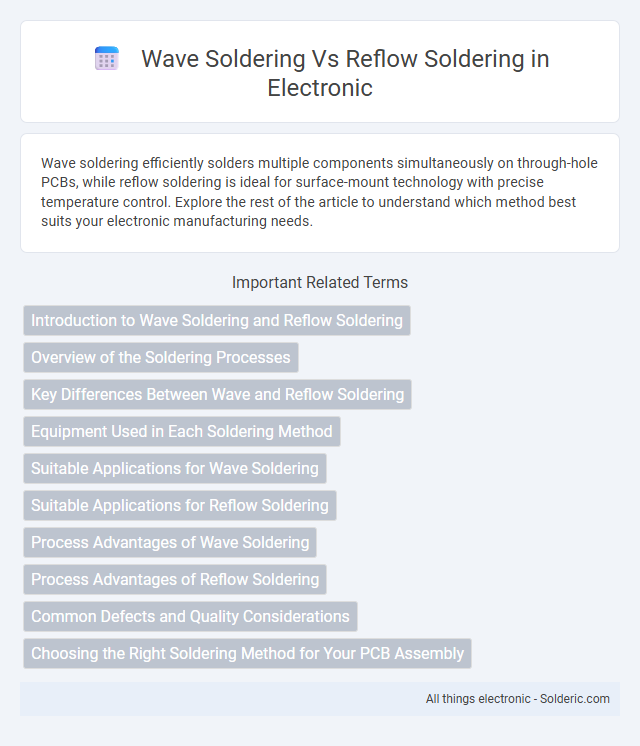Wave soldering efficiently solders multiple components simultaneously on through-hole PCBs, while reflow soldering is ideal for surface-mount technology with precise temperature control. Explore the rest of the article to understand which method best suits your electronic manufacturing needs.
Comparison Table
| Aspect | Wave Soldering | Reflow Soldering |
|---|---|---|
| Process Type | Through-hole and some surface mount components | Primarily surface mount components (SMT) |
| Temperature Range | 240degC to 270degC (solder wave) | 180degC to 250degC (reflow oven zones) |
| Application | Mass soldering of through-hole PCBs | Mass soldering of SMT PCBs |
| Speed | Faster for through-hole boards | Faster for dense, small components |
| Precision | Less precise, may cause bridging on SMT | High precision, optimized for fine-pitch SMT |
| Equipment Cost | Moderate initial cost | Higher initial investment |
| Suitability | Through-hole heavy PCB assemblies | SMT-heavy PCB assemblies |
| Defects | Possible solder bridges, tombstoning | Reduced defects, controlled reflow profile |
| Flux Usage | Flux applied prior to solder wave | Flux applied as solder paste on pads |
Introduction to Wave Soldering and Reflow Soldering
Wave soldering uses a molten wave of solder to join components to printed circuit boards (PCBs), ideal for through-hole technology with high production volumes. Reflow soldering involves applying solder paste to surface-mount components and heating the assembly until the solder melts and solidifies, enabling precise and reliable surface mount technology (SMT) connections. Understanding these soldering techniques helps you select the appropriate process for your PCB assembly needs based on component type and production scale.
Overview of the Soldering Processes
Wave soldering uses a continuous wave of molten solder to simultaneously solder electronic components onto a printed circuit board (PCB), making it ideal for through-hole components. Reflow soldering involves applying solder paste to surface-mounted components on a PCB, then heating it in a controlled oven to melt and solidify the solder, ensuring precise joints. Both techniques are essential in electronics manufacturing, with wave soldering favored for bulk and through-hole assembly and reflow soldering optimized for surface-mount technology (SMT).
Key Differences Between Wave and Reflow Soldering
Wave soldering involves passing PCBs over a wave of molten solder, enabling simultaneous soldering of through-hole components, whereas reflow soldering heats PCBs with solder paste to attach surface-mount devices (SMDs). Wave soldering is typically used for PCB assemblies with predominantly through-hole components, while reflow soldering excels in high-density and complex SMD applications. The primary differences include equipment complexity, process temperature profiles, and suitability for component types, with wave soldering offering faster throughput for certain designs and reflow providing precision for multilayer PCBs.
Equipment Used in Each Soldering Method
Wave soldering utilizes a conveyor system that passes printed circuit boards over a wave of molten solder, equipped with fluxing stations and preheaters to ensure proper solder flow, ideal for through-hole components. Reflow soldering employs a reflow oven that heats boards with surface-mounted devices using precise temperature profiles through preheat, soak, reflow, and cooling zones. Your choice of equipment depends on the component type and production volume, as wave soldering excels in mass assembly of through-hole parts while reflow soldering suits fine-pitch surface mount technology.
Suitable Applications for Wave Soldering
Wave soldering is ideal for through-hole components and mixed technology printed circuit boards (PCBs) with both through-hole and surface mount devices (SMDs). It excels in high-volume production of assemblies with predominantly through-hole parts, such as power supplies, connectors, and automotive electronics. This method ensures efficient solder joint formation on pins and leads, especially for large or complex boards where manual soldering would be impractical.
Suitable Applications for Reflow Soldering
Reflow soldering is ideal for surface mount technology (SMT) components on densely populated printed circuit boards (PCBs) due to its precise temperature control and minimal thermal shock. Your electronic assemblies, including small passive components, complex ICs, and fine-pitch devices, benefit from reflow's uniform heating process that ensures high-quality solder joints. This method is commonly used in consumer electronics, automotive, and telecommunications industries requiring reliable, high-volume production.
Process Advantages of Wave Soldering
Wave soldering offers a rapid and cost-effective solution ideal for high-volume through-hole PCB assembly, delivering consistent solder joints with excellent mechanical strength. This process excels in soldering components with multiple leads simultaneously, reducing production time and minimizing manual intervention. Your manufacturing benefits from enhanced reliability and superior thermal control compared to other soldering methods, ensuring robust electrical connectivity.
Process Advantages of Reflow Soldering
Reflow soldering offers precise temperature control and uniform heating, minimizing thermal stress on sensitive components compared to wave soldering. This process supports fine-pitch and small component placement with higher accuracy, improving overall assembly quality. Your production benefits from greater flexibility in solder paste application and reduced risk of bridging or defects.
Common Defects and Quality Considerations
Wave soldering often encounters defects such as solder bridging, tombstoning, and insufficient wetting, which compromise joint integrity and electrical performance. Reflow soldering commonly faces issues like cold joints, solder balls, and voids within solder joints, impacting reliability and mechanical strength. Understanding these quality considerations helps you optimize process parameters to minimize defects and ensure consistent electronic assembly performance.
Choosing the Right Soldering Method for Your PCB Assembly
Wave soldering excels in high-volume PCB assembly with through-hole components, offering rapid and consistent soldering for robust mechanical connections. Reflow soldering is ideal for surface-mount technology (SMT) components, providing precise temperature control to prevent damage and ensure strong solder joints. Selecting between wave and reflow soldering depends on component types, production volume, and desired throughput for optimal PCB assembly quality.
Wave soldering vs reflow soldering Infographic

 solderic.com
solderic.com